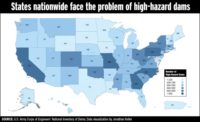The Mississippi River & Tributaries flood control system fought like a champ through the record-breaking floods of 2011. Now it has an estimated $2 billion worth of scars to prove it.
The U.S. Army Corps of Engineers doesn’t have the money to fix the MR&T system, but it already has identified 2,534 locations that need attention, at least 160 of which it says would not be able to withstand another flood.
In an effort to rally the kind of broad support that was behind the genesis of the Corps’ MR&T Project, which was created after the disastrous floods of 1927, on Aug.12 the Corps will release a ranked, ordered, regional, prioritized list of the damages that pose the greatest threat to public safety in the event of another flood.
"Yes, MR&T performed fantastic, but we have some weak areas that may not survive even a lesser flood," says Scott Whitney, regional flood risk manager for the Corps’ Mississippi Valley Division. "We want the public who live behind these levees to know we currently do not have the funding to do these items on the list. We want the public to know there will be some life safety issues we possibly won’t get to before the next flood season."
Rainfall exceeded 600 to 1,000 percent of the normal average from April 21 to May 3 over a significant portion of six states in the MR&T project area, Whitney says. From Illinois to Louisiana, the Mississippi reached record levels. "The magnitude and duration are unprecedented," Whitney says. "We’ve been in flood activity since the first of March."
For the first time in the MR&T’s history, all three of the systems emergency relief valves—the floodways of Birds Point-New Madrid, Bonnet Carre and Morganza—were called into operation simultaneously. The Corps estimates successful operation of the MR&T protected 4.5 million people and more than 10 million acres of land, and prevented more than $108 billion in damages.
Since the project’s inception in 1928, the nation has contributed $13 billion toward the MR&T’s planning, construction, operation and maintenance. The Corps estimates the MR&T has prevented a total of $350 billion in flood damages, representing a 27:1 return on that investment. "Such astounding figures place the MR&T project among the most successful and cost effective public works projects in the history of the United States," Whitney says.
Yet, ironically, MR&T is a bit of a victim of its own success.
"It was amazing to see that the MR&T performed," says Freddie Rush, executive vice president of the Mississippi Valley Branch of the Associated General Contractors of America. "The amount of water flowing in the river above Vicksburg was greater than the 1927 flood, but the fact that all this water was passed down the river didn’t get the amount of attention it got in 1927."
Tackling fixes to the MR&T using the Corps’ annual civil works funding will be slow, piecemeal, and costly. The Corps wants the public to know the nature of damages throughout the MR&T, and repair costs and schedule with the current level of funding. "The public has an interest in knowing how many years they will have to live behind levees that are now insufficient," Whitney says.









Post a comment to this article
Report Abusive Comment